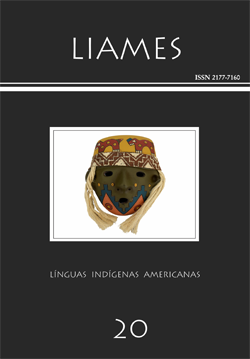Abstract
The present paper lists and illustrates eleven strategies that are systematically used by Shipibo-Konibo speakers in order to comment live soccer matches in the context of an indigenous soccer cup informally called “Mundialito Shipibo”. We argue that these lexical, morphosyntactic and discursive strategies can be classified into three types according to their function: iconic strategies, which attempt to present the information more vividly (onomatopoeic forms and ideophones, reduplications, parallel structures and hearsay-quotatives); emotional strategies, which are used by soccer commentators to express their emotions and their feelings (interjections, player-directed speech and diminutives); and proximity strategies, which bring the speech closer to the Shipibo-Konibo audience (lexical Shipibo-Konibo innovations, vocatives, evidential access configurations and code alternations). These various strategies are crucial for understanding the new social dynamics that the Shipibo-Konibo language is getting into as a consequence of becoming an urban language, and are clearly creating a new speech genre. The new social uses that the Shipibo-Konibo people are giving to their language and the features that the language is developing in this new social context are crucial to understand the future of Shipibo-Konibo and other minority languages in Peru.
References
Bergh, Gunnar; Sölve Ohlander (2012). English direct loans in European football lexis. In Cristiano Furiassi; Virginia Pulcini; Félix Rodríguez González (eds.). The anglicization of european lexis, pp. 281-304. Amsterdam: John Benjamins. https://doi.org/10.1075/z.174
Elías-Ulloa, José (2011). Una documentación acústica de la lengua Shipibo-Conibo (Pano), con un bosquejo fonológico. Lima: Pontificia Universidad Católica del Perú.
Guillén, Maricielo (2018). Hacia una tipología de las cláusulas en shipibo-konibo: evidencia desde la narración futbolística. Bachelor’s thesis. Lima: Pontificia Universidad Católica del Perú. Available at: http://hdl.handle.net/20.500.12404/13370
Jurafsky, Daniel (1996). Tendencies in the semantics of the diminutive. Language 72(3): 533-578. doi: 10.2307/416278
Hildebrandt, Kristine A.; Jany, Carmen; Silva, Wilson Silva (eds.). (2017). Introduction. In. Kristine Hildebrandt; Carmen Jany; Wilson Silva (eds.). Documenting variation in endangered languages. Special Publication 13: 1-5 Language Documentation & Conservation. Honolulu: University of Hawai'i Press. Link: http://hdl.handle.net/10125/24754
Labov, William (1972). Sociolinguistic patterns. Philadelphia, PA: University of Pennsylvania Press.
Lavric, Eva (2008). Introduction. In Eva Lavric; Gerhard Pisek; Andrew Skinner; Wolfgang Stadler (eds.) The linguistics of football (Language in Performance 38), pp. 5-8. Tübingen: Gunter Narr (2008).
Mansfield, John (2015). Consonant lenition as a sociophonetic variable in Murrinh Patha (Australia). Language Variation and Change 27: 203-225. doi:https://doi.org/10.1017/S0954394515000046
Mateo, Marino (2018). “Qué tal… amables oyentes… nokon kaibobo”: La “shipibización” del discurso castellano en programas radiales shipibos. Bachelor’s thesis. Lima: Pontificia Universidad Católica del Perú. Link: http://hdl.handle.net/20.500.12404/13114
Monod, Aurora; Becquey, Cédric (2008). De las unidades paralelísticas en Las Tradiciones Orales Mayas. Estudios de Cultura Maya 32(1): 111–53. doi: http://dx.doi.org/10.19130/iifl.ecm.2008.32.70
Nagy, Naomi (2009). The challenges of less commonly studied languages: Writing a sociogrammar of Faetar. In James N. Stanford; Dennis R. Preston (eds.). Variation in indigenous minority languages (Studies in Language Culture and Society 25), pp. 397-417. Philadelphia: John Benjamins. https://doi.org/10.1075/impact.25.20nag
Oisel, Guillaume (2017). Re-evaluation of the evidential system of Lhasa Tibetan and its atypical functions. Himalayan Linguistics 16(2): 90-128. doi: 10.5070/H916229119
Prieto, Alejandro (2018). Estrategias de composición en los cantos kakataibo. Una aproximación comparativa. Master’s thesis. Lima: Pontificia Universidad Católica del Perú. http://hdl.handle.net/20.500.12404/13425
Suarez, Ronald (2018). Radio interview. https://www.spreaker.com/user/10593901/entrevista-a-ronald-suarez
Tournadre, Nicolas; LaPolla, Randy J. (2014). Towards a new approach to evidentiality: Issues and directions for research. Linguistics of the Tibeto-Burman Area 37(2): 240-263. https://doi.org/10.1075/ltba.37.2.04tou
Valenzuela, Pilar (2003a). Transitivity in Shipibo-Konibo grammar. Ph.D dissertation. Eugene: University of Oregon. http://www.etnolinguistica.org/tese:valenzuela-2003
Valenzuela, Pilar (2003b). Evidentiality in Shipibo-Konibo, with a comparative overview of the category in Panoan. In Alexandra Y. Aikhenvald; R.M.W. Dixon (eds.). Studies in Evidentiality, pp. 33–61. Amsterdam: John Benjamins.
Valenzuela, Pilar M. (2005). Participant agreement in Panoan. In Nikolaus P. Himmelmann; Eva Schultze-Berndt (eds.). Secondary predication and adverbial modification: The typology of depictives, pp. 259–298. Oxford: Oxford University Press.
Valenzuela, Pilar (2010). Ergativity in Shipibo-Konibo. In Spike Gildea; Francesc Queixalós (eds.). Ergativity in Amazonia, pp. 65–96. Amsterdam: John Benjamins
Valenzuela, Pilar (2017). Armonía transitiva en Pano y Takana. In Antoine Guillaume; Pilar Valenzuela (eds.). Estudios sincrónicos y diacrónicos sobre lenguas Pano y Takana. Amerindia 39(1): 1-49. https://www.vjf.cnrs.fr/sedyl/amerindia/articles/pdf/A_39_01.pdf
Zariquiey, Roberto (2015). Diferencias intergeneracionales en el uso de construcciones de cambio de referencia entre hablantes de Kakataibo (Pano, Perú). Proceedings of the Conference on Indigenous Languages of Latin America VII. Austin: The University of Texas at Austin.
Zariquiey, Roberto, Valenzuela, Pilar (submitted). The Pano language family. In Patience Epps; Lev Michael (eds.). Amazonian Languages. An International Handbook (to be published by De Gruyter Mouton).
The LIAMES: Línguas Indígenas Americanas uses the Creative Commons license (CC), thus preserving the integrity of the articles in an open access environment.



